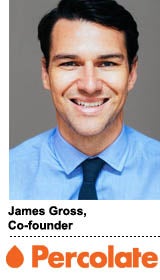 Percolate, which has been compared to social publishing platforms like Buddy Media, has raised $40 million to take on enterprise marketing cloud acquirers and standalone social point solutions.
Percolate, which has been compared to social publishing platforms like Buddy Media, has raised $40 million to take on enterprise marketing cloud acquirers and standalone social point solutions.
The Series C round, led by Lightspeed Venture Partners, brings Percolate’s total funding to $74.5 million. It raised $24 million in Series B last spring, which the company’s co-founder, James Gross, said is mostly still in reserve in the bank.
“This is a growth round, we don’t plan to be acquired, and we want to run out our mission as an independent company to the point of potentially one day going public,” he said.
In four years since the company’s founding, it has grown to more than 200 people, with plans to triple its headcount by the year’s end. Gross described plans for “aggressive expansion” into the San Francisco market to compete more closely with the marketing stacks from Oracle and Salesforce.com. The company also hopes to establish a global presence by opening an office in Singapore next year.
He said the company has grown revenue by more than 155% a year and serves more established brand customers like Unilever and GE, as well as newer, fast-growing upstarts like Airbnb.
Although Percolate could be classified as a content marketing shop, Gross, who formerly served as SVP of publishing for Federated Media, recognizes companies that focus on one function struggle to compete long-term.
“Many people who only focus on social … will need to pivot or get acquired,” he said. “We are building this orchestration and workflow for marketers where you can … plan [social] alongside television, marketing automation and digital advertising like banners.”
Percolate says its marketing systems manage campaign, workflow and digital assets, a need it believes is underserved. At the enterprise level, Percolate helps centralize campaign briefs across a variety of channels – an important feature because large brands like GE often work with dozens of agencies to execute a campaign cross-channel, and communication breakdowns occur frequently.
“There are a lot of analog workflow challenges we’re trying to solve for [because one campaign often involves] six agencies in 50 countries with 900 creative assets,” Gross said. “The marketer wants to know who did good, who was over/under budget and what delivered.”
Programmatic TV and native advertising are other growth areas for Percolate, but Gross claims there is a disjointed process between the buy and sell sides and a lack of true APIs to make such executions possible, at least in an automated function beyond Excel.
“The unfortunate thing for Percolate is, we essentially have a lot of the [creative] assets for TV, pre-roll and more, but you can’t actually deliver those assets to networks yet because the plumbing isn’t built the way it would be to push paid media to Facebook or Twitter through traditional RTB,” he said. “We manage the process up until multichannel network distribution, but the way TV networks will compete long-term is they will need to enable this more programmatically.”











